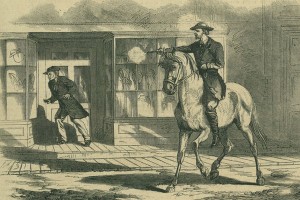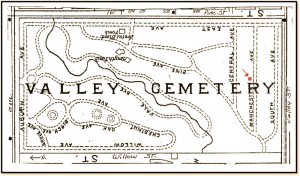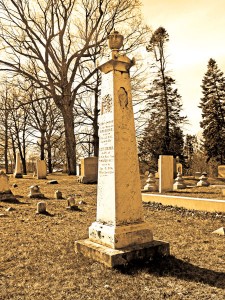
The famous series of illustrations that appeared in Frank Leslie’s Illustrated shortly following the raid badly botched the scene surrounding the fatal shooting of Elias Morrison. This is how the illustrator, dispatched to St. Albans by the New York City paper, envisioned it.
During the dramatic St. Albans Raid, one unfortunate civilian found himself in the wrong place at the wrong time. This was Elinus J. Morrison, a building contractor from Manchester, N.H., who was the only person killed that day.
Elinus is buried in Manchester. In the center of the family plot is a white marble obelisk that bears his name and the names of close family members.
Morrison was born in 1812 in Fairlee, Vt., the son of James and Martha Polton Morrison. As a young man, he followed his older brother George W. Morrison (who was to become one of New Hampshire’s most prominent lawyers) to Manchester and became an expert brick mason.
In 1840, Elinus married Mary Ann Elliott. In time they moved to Chelsea, Mass. and later to Salisbury, N.H. They and their five children returned to Manchester in the 1850s.
In a published genealogy of the Morrison family, Elinus was described as being of medium height, thick set, with sandy hair, and that he was “…a stirring, enterprising, capable businessman.” He prospered in his trade, working as a contractor on a variety of construction projects in New Hampshire, Massachusetts, Vermont, New York, and Pennsylvania. His specialty was building railroad bridges and tunnels.
On the day of the raid, Oct. 19, 1864, Elinus was finishing up his job as the construction foreman of the impressive new five-story brick Welden Hotel in St. Albans. His life was about to collide with the forces of history in the most tragic way.
The New York Times on Oct. 20, 1864, published a shocking account of a surprise Confederate raid. The story was telegraphed directly from St. Albans, Vt. soon after the events occurred:
“…[O]n Wednesday, Oct. 19, St. Albans was in a state of apparent quiet, common to New-England towns. Our informant, [railroad] conductor Baldwin, was standing on the steps of the American Hotel, just as the town bell rang out the hour of 3 o’clock, when he saw a man coming out of the door of the First National Bank, and as he did so a citizen on the steps knocked him down. A second was also floored; but the third raider had a pistol in his hand and the citizen retreated. The conductor thought the affair was the freak of some drunken men, but soon he saw symptoms of a disturbance at other points.
“Several men appeared to be rushing about with pistols, in parties of from five to ten. One of these gangs met a Mr. Morrison and presented a weapon to him, demanding his surrender. He answered, ‘You are joking, boys.’ They fired and he fell, weltering in his blood. Our informant saw him throw up his hands and then sink on the ground, and then he [Baldwin] realized for the first time that the village was attacked by an organized body of men, bent on pillage and regardless of human life.”
The 52-year-old Morrison and his workmen had heard the gunshots and instinctively ran towards the commotion.
As Elinus turned the corner onto Main Street, he found himself on the steps of Miss Beattie’s Millinery Shop. Local citizen Myron Wilson was in the center office of the St. Albans Messenger newspaper nearby. He heard his son yelling from outside, “There are horse thieves in the street!” Wilson looked out to see a band of 15 to 20 men “…opposite the offices and on either side…some on horseback, some on foot, engaged in unhitching horses attached to vehicles and fastened at the posts on the street.”
Wilson reported that he “… saw one of the horsemen aim a pistol and fire a shot which took effect in the body of said Morrison.” He had heard the horseman order Elinus to stop, and Elinus respond, “I don’t see it [meaning the gun]!” The raider answered him, “I’ll make you see it!”
As Wilson further recalled, “Morrison, after the pistol shot him, came off the steps and leaned against the corner of the building in a crouching position, and I said to him, ‘Are you hurt?’ I saw the blood coming from one of his hands.” Elinus responded, “Yes, they have shot me through the body.”
Adaliza Blakely, 17, a seamstress who worked for Miss Beattie, was outside the shop. Although at least two eyewitnesses had reported that the shooter was on horseback, Adaliza recounted, “I immediately turned and looked in the direction from which the report [gunshot] came and I saw a man with two pistols standing by his horses and about ten or twelve feet from where Mr. Morrison stood … I saw this man … fire twice with his pistols before Mr. Morrison was wounded.” She saw Elinus bend down and grab the left side of his abdomen.

The famous series of illustrations that appeared in Frank Leslie’s Illustrated shortly following the raid badly botched the scene surrounding the fatal shooting of Elias Morrison. This is how the illustrator, dispatched to St. Albans by the New York City paper, envisioned it. Map courtesy of Manchester, N.H. Historical Association
Wilson and Erasmus Fuller, the owner of a local livery stable, carried Elinus into a room in the back of the L. S. Dutcher & Son drug store. They placed him on a bed, and examined his wound, which appeared dire. Elinus was attended by Dr. Seth R. Day, and then was taken to his room at the American Hotel where he was further treated by Dr. John Branch.
His wife, Mary, had been summoned in Manchester. She came by rail as fast as she could, and arrived in time to be at Elinus’ side when he took his last breath.
The 15 to 22 Confederate raiders had fired their pistols recklessly to intimidate the citizenry, but at times they had deliberately aimed to kill. Elinus, it was reported, was targeted when he exchanged words with one of the raiders, and two other civilians were shot in separate incidents. Collins Huntington was shot in the back, injuring a rib, and Leonard Bingham was slightly wounded in the abdomen. These men were fortunate as their injuries were minor.
Within 24 hours, 14 of the “rebel ruffians,” as the New York Times called them, including the ringleader Lt. Young, were apprehended in Canada. Despite rigorous diplomatic efforts on the part of the U.S. government, the raiders were not extradited. It was determined that they were war combatants and the men were set free. The Canadians had seized bank notes and gold from the raiders, valued at $87,000 (in all $208,000 was taken). These funds were returned as partial restitution for financial loss to the St. Albans banks.

The Morrison family monument in the Valley Cemetery in Manchester, N.H. Elinus Morrison, who also built the building that today is the St. Albans Historical Museum, was killed in the St. Albans Raid 150 years ago this October.
Although Lt. Young was implicated as the murderer of Elinus Morrison, he was never charged with the crime. It would be reported later that on Oct. 18, 1864, Young was observed having a conversation with Morrison at the Welden Hotel construction site. It was speculated that Elinus must have been a Southern sympathizer, to be so obviously friendly with the leader of the raid. There was no proof offered then, nor has any been found in the historic record.
Elinus Morrison was honored with a religious observance at the American Hotel in St. Albans. His funeral was in Manchester where he was buried in the family plot at Valley Cemetery. His bereaved wife was left alone with their five children, who ranged in age from 7 to 21.
The raid on St. Albans was the northernmost land action of the Civil War. In a genealogy of the Morrison family published in 1880, the authors lamented, “It seemed a strange providence that he should have fallen by an act of war while engaged in peaceable pursuits, hundreds of miles from any known hostile force.”
By AURORE EATON
Manchester, N.H. Historical Association
Editor’s Note: This article is provided as a courtesy by the New Hampshire Union Leader in Manchester, N.H. The article summaries material originally published in four installments in the weekly “Looking Back” column written by Aurore Eaton, executive director of the Manchester Historical Association (April 22 and 29 and May 6 and 13 of this year). This shorter version, focusing mainly on Elinus Morrison, combines key information from the four articles. The full articles are available on Union Leader’s website: www.unionleader.com. To reach Aurore Eaton: auroreeaton@aol.com.




One Response to A Civil War Tragedy – Elinus J. Morrison, the raid’s lone fatality